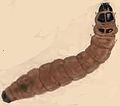Coleophora lusciniaepennella: Difference between revisions
Appearance
Content deleted Content added
KolbertBot (talk | contribs) m Bot: HTTP→HTTPS (v485) |
|||
| Line 31: | Line 31: | ||
==External links== |
==External links== |
||
*[https://lepidoptera.eu/species/1631 Lepidoptera Mundi] by Christopher Jonko |
|||
| ⚫ | |||
*[http://www.lepiforum.de/lepiwiki.pl?Coleophora_Lusciniaepennella Lepiforum.de] |
*[http://www.lepiforum.de/lepiwiki.pl?Coleophora_Lusciniaepennella Lepiforum.de] |
||
| ⚫ | |||
{{Taxonbar|from=Q4247697}} |
{{Taxonbar|from=Q4247697}} |
||
Revision as of 16:24, 8 June 2018
| Coleophora lusciniaepennella | |
|---|---|

| |
| Scientific classification | |
| Kingdom: | |
| Phylum: | |
| Class: | |
| Order: | |
| Family: | |
| Genus: | |
| Species: | C. lusciniaepennella
|
| Binomial name | |
| Coleophora lusciniaepennella (Treitschke, 1833)[1]
| |
| Synonyms | |
| |
Coleophora lusciniaepennella is a moth of the Coleophoridae family. It is found in most of Europe, except the Iberian Peninsula, the Mediterranean islands and most of the Balkan Peninsula and Russia. It occurs in forest-steppe biotopes.
The wingspan is 10-13,5 mm. The moth flies from June to July depending on the location.
The larvae feed on Myrica gale, Populus tremula, Salix alba, Salix aurita, Salix babylonica, Salix caprea, Salix cinerea, Salix dasyclados, Salix fragilis, Salix glabra, Salix pentandra, Salix repens, Salix triandra and Salix viminalis. They create a bivalved composite leaf case of 8–10 mm. It is rather strongly compressed and keeled and has a mouth angle of 30-45°.[2] Full-grown larvae can be found at the end of May.
-
Larva
References
External links
- Lepidoptera Mundi by Christopher Jonko
- Lepiforum.de
- UK Moths

